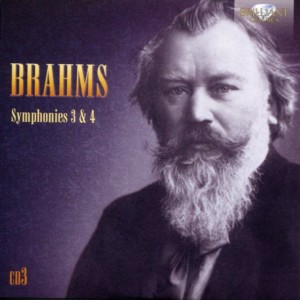 Brahms’ Symphony No. 3 will forever be associated (at least, in my mind) with this scene from the ’70s British TV series Fawlty Towers.
Brahms’ Symphony No. 3 will forever be associated (at least, in my mind) with this scene from the ’70s British TV series Fawlty Towers.
If you’re not familiar with Fawlty Towers, it’s about a snobbish, extremely rude hotel owner named Basil Fawlty (played to perfection by Monty Python alum John Cleese) who, along with his shrew wife Sybil (Prunella Scales) own and operate Fawlty Towers.
In this short-but-hilarious scene, Sybil chastises Basil for not getting to the chores she laid out for him to do (in this case, I believe it was to compose the day’s food menu). He dashes back to his typewriter to begin the task.
So, I’ve been listening to Brahms’ Third Racket this morning.
All joking aside, Brahms’ Symphony No. 3 in F Op. 90 is a remarkable piece of work. As I’ve written before, Brahms’ symphonies seem to lack the power and majesty of Beethoven’s. But they are brilliant compositions in their own right.
According to its entry on Wikipedia:
Symphony No. 3 in F major, Op. 90, is a symphony by Johannes Brahms. The work was written in the summer of 1883 at Wiesbaden, nearly six years after he completed his Second Symphony. In the interim Brahms had written some of his greatest works, including the Violin Concerto, two overtures (Tragic Overture and Academic Festival Overture), and the Second Piano Concerto.
The premiere performance was given on 2 December 1883 by the Vienna Philharmonic Orchestra, under the direction of Hans Richter…proclaimed it to be Brahms’ Eroica. The symphony was well received, more so than his Second Symphony. Although Richard Wagner had died earlier that year, the public feud between Brahms and Wagner had not yet subsided. Wagner enthusiasts tried to interfere with the symphony’s premiere, and the conflict between the two factions nearly brought about a duel.
After each performance, Brahms polished his score further, until it was published in May 1884.
Brahms was 50 when he completed Symphony No. 3.
I like Brahms’ Third Racket. But it’s Symphony No. 4 in E minor Op. 98 that has become the first of his symphonies to grab me from Movement I (“Allegro non troppo”). And not just because of the use of pizzicato again, a musical style that always makes me smile. (It reminds me of cartoon characters sneaking up behind someone on tip toes.)
Symphony No. 4 is lush, melodic, and sweeping. Whatever it is I like in my Classical music, whatever it is that grabs my attention and entices me to listen, is present in this symphony. I hadn’t heard it up to this point in Brahms’ music. Symphony No. 4 does it for me.
According to its entry on Wikipedia,
Symphony No. 4 in E minor, Op. 98 by Johannes Brahms is the last of his symphonies. Brahms began working on the piece in Mürzzuschlag, then in the Austro-Hungarian Empire, in 1884, just a year after completing his Symphony No. 3, and completed it in 1885.
The symphony is rich in allusions, most notably to various Beethoven compositions. The symphony may well have been inspired by the play Antony and Cleopatra, which Brahms had been researching at the time.
Progressive rock group Yes’ keyboardist Rick Wakeman used part of the symphony on the instrumental “Cans and Brahms” from the 1971 album Fragile.
Brahms was 52 when he completed Symphony No. 4.
The musicians on Brahms CD 3 are:
Netherlands Philharmonic Orchestra
Jaap van Zweden, conductor
